#tale of genji
Text
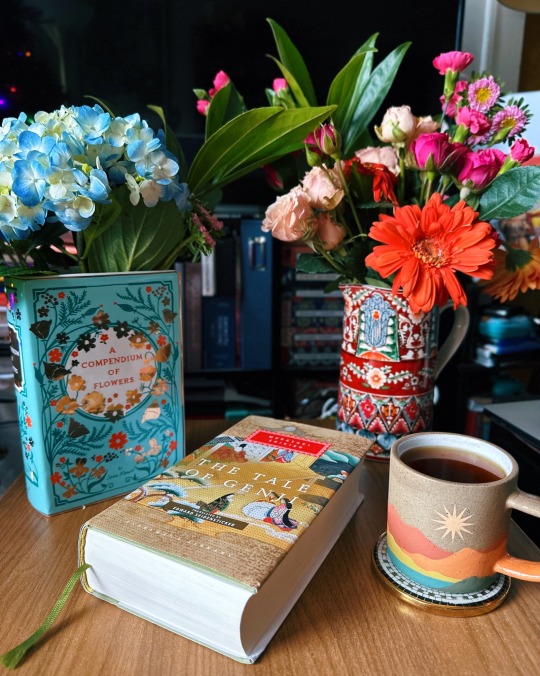
Genji is not a perfect person, but there’s a purity to him, a beauty that’s clearly meant to be lauded, particularly in contrast to later chapters. He’s in love with love, a true romantic, and his sometimes unwise affairs are motivated by a true sense of love. He never abandons one of his lovers, which in this time is crucial. No matter the shame it brings to himself, he tries to find a way to honor the women he’s fallen for. He’s charming. No one can not love him, or ultimately forgive him his faults.
The age of Tale of Genji had strict rules of romance—of how flirtations worked (largely intermediaries and poetry), of how commitments worked, of how aloof vs. present it was appropriate to be (it’s good to commit but bad to hoard or become jealous). It was possible to love too much. Genji is accused of this, but he always remembers to care for the people he is responsible for—once he grows up that is.
Early in the text, he neglects his wife, and he also neglects “the Rokujo lady.” The Rokujo lady becomes so jealous and enraged that her spirit begins to sicken his wife. This ghost returns more than once over the course of the text. She has grown sick from obsession and neglect, and Genji pays the price for it. It’s part of what motivates him to always care for the women he romances for the rest of his life.
Later, in the “Uji” chapters, young Kaoru and prince Niou also love too much. Niou is impulsive like Genji but also flighty, and Kaoru is serious like Genji but also obsessive. Both men pursue the women at Uji with insistence that the text can’t quite forgive as it could for Genji. Both, somehow, go too far—perhaps in their attempts to hoard, or in their impatience.
2K notes
·
View notes
Text
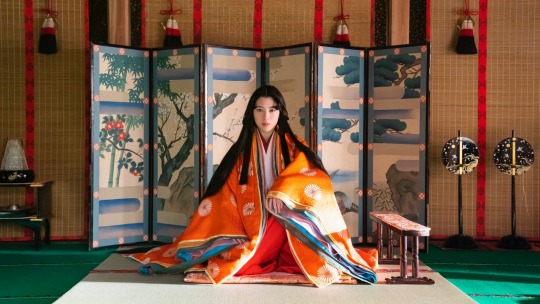
Ayaka Miyoshi in Junihitoe wo Kita Akuma / The Devil Wears Junihitoe Kimono (2020)
#ayaka miyoshi#miyoshi ayaka#junihitoe ko kita akuma#the devil wears junihitoe kimono#十二単衣を着た悪魔#tale of genji#heian period#japanese movie#j movie#japanese drama#j drama#jdrama#dorama#japan#asian drama#asian movie
94 notes
·
View notes
Text



The Tale of Genji (1987) dir. Sugii Gisaburō
#film#animation#anime#genji monogatari#genji and kiritsubo make me so sad#this scene is so striking in its loneliness!!!!!!#its not even 3 am and im on genji posting hours#tale of genji
54 notes
·
View notes
Text
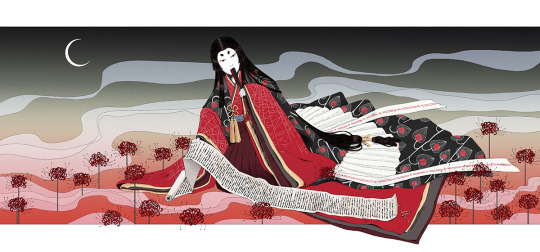
A professor's assistant at Tokyo University uncovers a curious manuscript whose author weaves an elegant tale of the twilight years of the Heian court. As she reads between the gossamer lines of the narrator's account of a moonlit assignation, the quiet and unassuming scholar reflects on what happens in the shadows cast by civilization and enlightenment.
complete at 3000 words . ( on AO3 ) . illustration by @paristandard
39 notes
·
View notes
Text

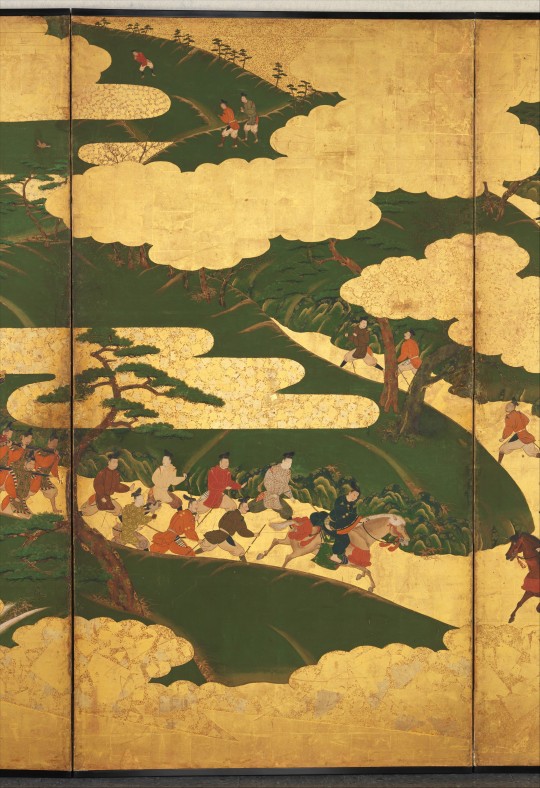
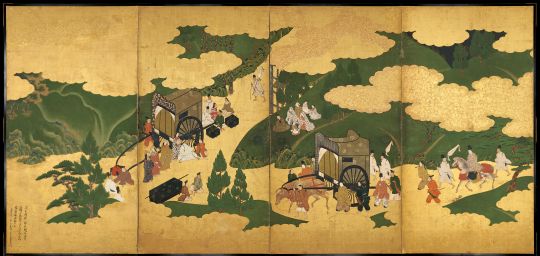
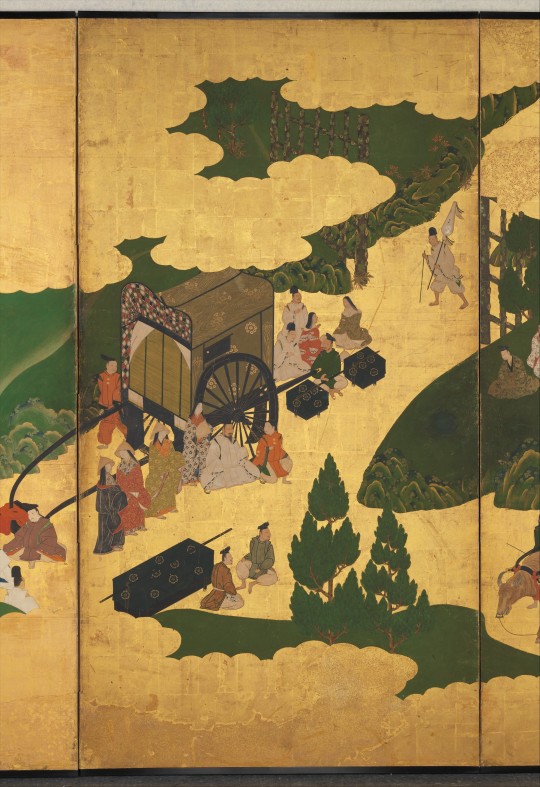
An Imperial Excursion” (Miyuki), “A Boat Cast Adrift” (Ukifune), and “The Barrier Gate” from Tale of Genji by Tosa Mitsuyoshi, mid-16th–early 17th century
#Tosa Mitsuyoshi#mdpjapan#japanese art#japan#undated#16th c. japan#17th c. japan#tale of genji#illustrated manuscript#manuscript
71 notes
·
View notes
Text

Taki Shusui (Japanese, b. 1938), Kumoi no kari from Tale of Genji, color woodblock print, signed Shusui, 10¾ × 15¾ in., 27.3 × 40 cm.
138 notes
·
View notes
Text



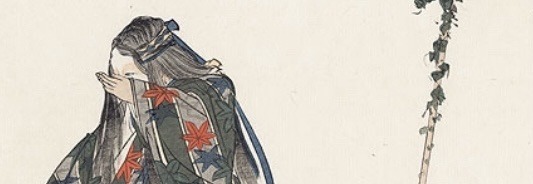

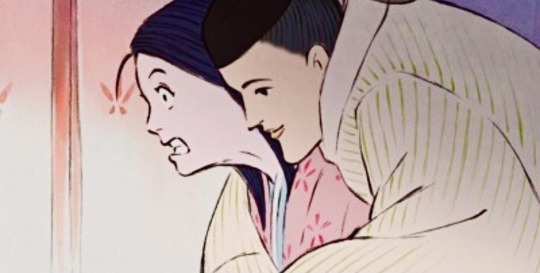
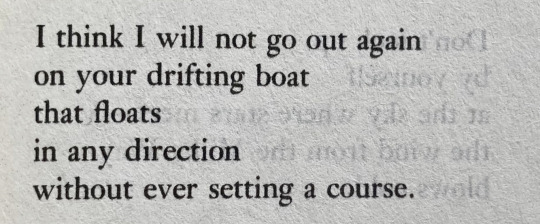



Women rejecting male suitors in premodern Japanese literature
‘Sotoba Komachi’ (14th century) by Kan'ami Kiyotsugu, trans. Donald Keene • Scene from It Was a Faint Dream (1974) dir. Akio Jissôji (based on Towazugatari (1306) by Lady Nijo) • The Tale of Genji (~1010) by Murasaki Shikibu, trans. Royall Tyler • Detail from Unai appearing as a young maiden (from Motomezuka, Act 1) by Tsukioka Kogyo (1900) • The Tale of the Bamboo Cutter (9th century) by Anonymous, trans. Donald Keene • Kaguya rejecting the emperor in The Tale of Princess Kaguya (2013) dir. Isao Takahata (based on The Tale of the Bamboo Cutter) • Untitled poem by Izumi Shikibu (11th century) trans. Jane Hirshfield and Mariko Aratani • Kagero Nikki (~974) by Michitsuna’s Mother, trans. Donald Keene • Utsusemi from "Fifty-four Chapters of The Tale of Genji” (1852) by Utagawa Hiroshige • Untitled poem (9th century) by Sosei, trans. Kenneth Rexroth
#classical japanese literature#japanese literature#japanese poetry#books#literature#classical literature#medieval#medieval literature#web weaving#ellis reads#the tale of genji#izumi shikibu#murasaki shikibu#ono no komachi#tale of genji#genji monogatari#sosei#the tale of the princess kaguya#i was thinking about how unusual it is to find a classical literary culture that so prominently features female rejection of male courtship#it appears in so many places. young women rejecting elegible suitors. wives rejecting husbands. lower rank women rejecting princes.#female rejection became a key part of the social and literary code#these rejections weren’t always respected by the suitors or condoned by the authors writing them or those around them#but they were nevertheless recorded and thus immortalised#and so we can remember michitsune’s mother not just as a passive victim of a patriarchal system but as one who asserted her agency to say no#circumstances made her powerless in many ways but she still exists and asserts her selfhood through her memoirs#it’s just. incredible and humbling#also ik Ukifune isn’t anywhere on this but she was the inspiration for it <3 thinking about her always
214 notes
·
View notes
Text
The gift of today is that after reading 700 pages of The Tale of Genji, I’ve started calling it “Real Housewives of the Heian Court” and as a result I can’t stop giggling.
8 notes
·
View notes
Photo

A pamphlet from the Tokugawa Art Museum (徳川美術館) in Nagoya, Aichi Prefecture, featuring a scene from “The Tale of Genji” (源氏物語) by Murasaki Shikibu (紫式部) as depicted in the illustrated handscroll “Genji Monogatari Emaki” (源氏物語絵巻) produced around 1120-1140
Acquired at the museum November 27, 1994
#愛知県#aichi prefecture#名古屋市#nagoya#徳川美術館#tokugawa art museum#japanese literature#紫式部#murasaki shikibu#源氏物語#genji monogatari#tale of genji#japanese art#源氏物語絵巻#genji monogatari emaki#絵巻#emaki#pamphlet#ephemera#printed ephemera#paper ephemera#museum#crazyfoxarchives
41 notes
·
View notes
Text
World Literature Series: The Tale of Genji
TITLE: Genji Monogatari (The Tale of Genji)
AUTHOR: Murasaki Shikibu
DATE: before 1021
COUNTRY, REGION, OR PEOPLE: Japan
TYPE: novel
BACKGROUND: Generally considered to be the world’s first novel, The Tale of Genji was written during the Heian period of Japanese history. During this time, from 794 to 1185 CE, Japan was in a time of peace and strong national culture flourished. Two esoteric sects of Buddhism rose, Tendai and Shingon, both of which supported and were supported by the Japanese aristocracy that had gained lots of power and wealth during this time.
Murasaki Shikibu was a lady-in-waiting at the Imperial court of Japan. As a woman, she was not educated in the government language of Chinese, which is why The Tale of Genji was written in Japanese--the strength of the Japanese language was largely carried by women who were prevented from learning Chinese.
SYNOPSIS: Genji is a young prince, but his position in the Emperor’s household is not stable. His mother is dead and his father cannot forget her. Genji starts of a series of ill-advised and questionable love affairs. When the Emperor dies, Genji’s half-brother takes the throne and Genji is pushed out.
The novel follows court life, intricate politics, and Genji’s exile and continued love life, until coming to an abrupt ending. It is debated whether this was intentional, if later chapters have been lost to time, or if Murasaki Shikibu never finished writing her story.
THEMES: Power, love, the importance of youth, gender.
Main post for the World Literature series.
39 notes
·
View notes
Text

I’m still just getting my thoughts together on The Tale of Genji by Lady Murasaki Shikibu, translated by Edward G. Seidensticker, which was an epic that took me by surprise. Considered by many to be the first known novel, written in the early 11th century in Japan by a woman at court, this book is full of drama, wit, poetry, and messiness.
Genji is his father’s favorite. A beautiful, naturally charming prince, he is considered to be too good to be true—there was an idea that if too beautiful, you would be doomed to die early. His father is unable to name him crown prince due to court politics, and so he is a commoner at court, but one of tremendous influence. Genji is in love with love, and chases after women left and right—but is very serious about these affairs, making it a point not to abandon the women he seduces. It is a story of romance, intrigue, and growth.
One thing I was surprised by is the modern-feeling self-awareness of the text. Many analyses identify the 2nd protagonist, Kaoru, as possibly the first anti-hero, but I’d argue Genji is. Like many early mythic figures, he is loved by all but not without flaws. When he adopts (kidnaps) Lady Murasaki at a young age specifically to groom her into a future wife, the text does not shy away from how inappropriate it is. Characters disapprove, and the text is often cynical or wry about Genji’s choices. It does the same when Genji’s seductions turn coercive. It forgives Genji, but does excuse him, and that was something I did not expect from such an early text. This reflectiveness is part of what makes the book feel like a novel, rather than an epic poem of some kind.
#the tale of genji#murasaki shikibu#books in translation#classic literature#japanese literature#my book reviews#tale of genji
51 notes
·
View notes
Text



My Japan Trip : Uji
It's not everyday you see cool vending machines. The bottom one is the art of "Tale of Genji" which Uji is known for
#my japan trip#uji#kyoto#japan#kansai#japan travel#kimono#geisha#samurai#tale of genji#japanese art#japanese vending machine#vending machine
46 notes
·
View notes
Text
Touken Ranbu: The Contradictory Tale of Genji
Went in expecting fanservice and just a good time, left impressed.
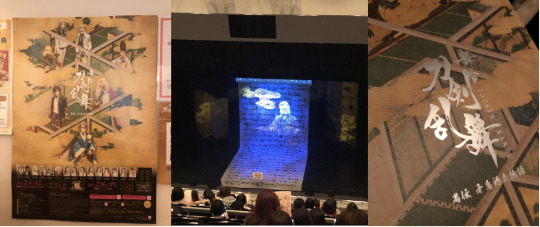
Part 1/3 - Plot:
The videogame source material has a very barebones plot because it knows what it is: a gatcha game for fujoshi to collect sword husbandos. Basically, something evil is trying to change (Japanese) history and make the universe implode. You, the player, are an onmyoji or priestess who is summoning famous swords like mad to save the world. The touken danshi themselves basically have the personalities of their famous historical figure owners or forgers coupled with quirks related to random facts and legends surrounding them. Some come with a Hachiko streak from losing their masters or their service in some darker parts of history. (only your love can heal them!). Classic gatcha game fare. In other words, there is a lot of room to be creative with this framework. Just look at all the sexy derivative works spawned from the thirsty fujoshi. This aspect of the fandom is surprisingly relevant to the plot of the musical. Stick around and find out.
Anyways, the plot of this specific show features a Tale of Genji crossover. The usual evil is messing with history again and a squad of swords are dispatched to fix it. The problem of the day is the entire Heian court has been isekai-ed into the novel Tale of Genji. The author Murasaki Shikibu and her fans have all gotten merged with the characters of the book. The Heian era swords are unavailable for vague reasons, leaving a bunch of young swords not forged in this era to untangle fact from fiction.
Thus, we start with team Kanesada finding themselves escorting a lady-in-waiting who explains that everyone around her has been suddenly larping Tale of Genji and she’s the only sane person left in court. They realize they are trapped in the book and reenact all the early chapters as they figure out how to undo the curse. Some of the more hot-tempered swords try to brute force their way out only to realize that book characters have protagonist halos to protect them from getting KOed. At the center of this vortex, the titular character Hikaru Genji is effectively an NPC who has gained sentience a la RE: Creators. We learn he functions similarly to the sword boys as the embodiment of the book. Not being a weapon, he can’t do much by way of fighting but he is unkillable and can act as dungeon master in his own story by transferring protagonist status to his victims. In other words, Genji can possess targets to simulate his story as a substitute while he dicks off. He uses this power to go OOC and try to retcon his own story. This is all quite convenient for him since he has a complicated relationship with his author. He is half reverential of her and half resentful. This culminates in Genji ultimately killing his own author. In the merged universe, Murasaki Shikibu and her readership have merged with the female leads of The Tale of Genji with Murasaki taking the role of the unobtainable Fujitsubo no Nyogo, Genji’s true love. In breaking the story with literal death of the author, all hell breaks loose with Genji going rogue.
As the touken danshi dig deeper, they learn the source of this chaos was a result of toxic fan culture! While many people enjoy Murasaki’s book and come away from it positively, a stalker fan voices his concerns that this is all vapid fiction with no value nor contribution to reality (the “wake up, loser” argument). They debate about the point of writing “fake” stories. While Murasaki understands the man’s point of view, she disagrees and refuses to put down her brush as this work is her passion. The man becomes so upset he is taken over by the evil powers to cause the time rift and alter history. His reasoning is if everyone is so obsessed with the book, they may as well live in it rather than face the real world.
Back in the present, the touken danshi are having a bad time resolving the timeline. They complain about needing grandpa Mikazuki’s help and keep getting possessed by Genji to reenact chapters while he escapes to cause trouble elsewhere. However, during the final boss battle with evil Genji, the isekai-ed fangirls come to the rescue! As they reminisce about their love of the novel (well, it would be equivalent of a serialized magazine at time of publication) and how it was therapeutic or inspiring for their real lives, they begin to return to themselves. Now it’s important to note that Murasaki’s contemporaries did write derivative works or helped her transcribe chapters to share. Therefore, these fangirls are effectively ancient Japanese fanfiction authors and thus have power to end Genji as much as the original author does. But they love him as a character too much so are unable to strike the finishing blow and basically toss the responsibility to young Murasaki, Genji’s second wife who he had kidnapped as a child to groom into the perfect woman. Unable to bear the suffering and moved by the women in his life both as characters and as his fans, Genji lowers his protagonist’s halo and accepts death. The touken danshi are able to finally fix history and complete their mission. When they return to modern day, they hear news that archeologists have found physical evidence that Genji existed as a historical figure and thus a conspiracy theory is born! The touken danshi take this information with mixed emotions.
What an amazing story. The theme was deep without being too obtuse. The climax got meta and opened a lot of discussion about the value of fiction, derivative works, the dangers of escapism, censorship, and even spirituality. Definitely worth a second viewing to digest all this.
There was a mini-revue number in the end where the cast performed an umbrella dance to anachronistic Touken Ranbu music. Then the cast descended a staircase in parade order for final bows. It was a much-needed break from the heavy and complicated plot. It was also a small nod to the main cast’s Takarazuka roots or hina doll staging, which is a common set design when using Heian costume. The umbrella dance reminded me of the finale Sakura dance OSK does at the end of their performances. Perhaps this is a proud Osaka tradition. I haven’t seen a different Touken Ranbu show (yet) so I don’t know if this is a part of the brand.
#touken ranbu#tale of genji#takarazuka og#og lyfe#my thoughts#my meta#my rambles#my ramblings#otokoyaku#theatre#theater#touken ranbu musical#刀剣乱舞#宝塚#宝塚OG#nanami hiroki#seto kazuya#kai#akira#ayanagi sho
37 notes
·
View notes
Text

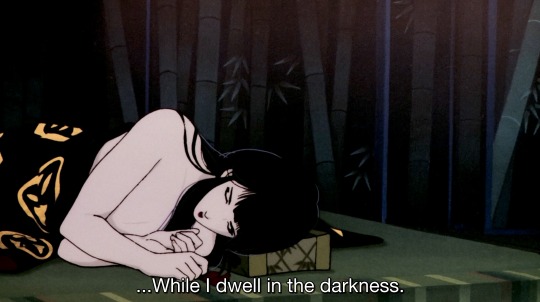
The Tale of Genji (1987) dir. Sugii Gisaburō
#film#movies#animation#animanga#tale of genji#genji monogatari#he's literally so dramatic look at him#pretty boy shining prince genji#falling in love with every half tragic woman and being a full disappointment to them all
43 notes
·
View notes
Text
Explain classic literature badly: Ridiculously handsome and brilliant young prince has never met a woman he didn't want to sleep with. 😅 (Tale of Genji, obviously)
#random things#tale of genji#explain literature badly#please put your clothes back on shining prince#said apparently no one ever
21 notes
·
View notes
Text


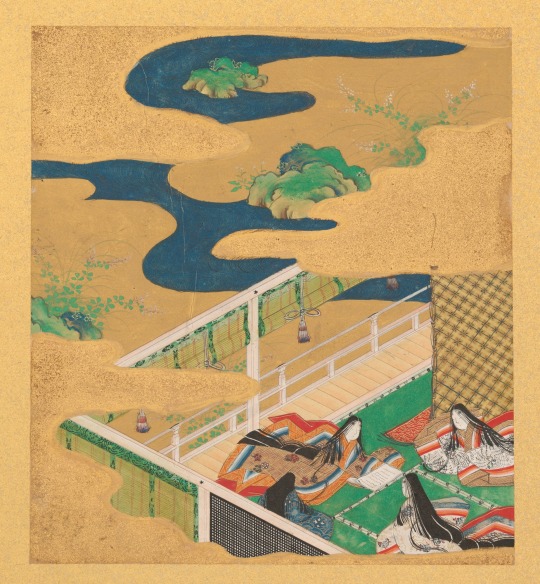


Scenes from The Tale of Genji, early 17th century Japan
85 notes
·
View notes